CeraVe is a drugstore skincare brand known for its gentle yet effective formulations suitable for those with dry skin and those with a compromised skin barrier.
The brand offers a range of products, from cleansers to moisturizers, that are designed to hydrate and nourish the skin with CeraVe’s three essential ceramides.

CeraVe offers two retinol serums formulated to address different skin concerns, so today, we’ll explore their formulas and uses in this CeraVe Retinol Resurfacing vs Renewing Retinol Serum post.
This post contains affiliate links, and any purchases made through these links will result in a commission for me at no extra cost to you. Please read my Disclosure for additional information.
CeraVe Retinol Resurfacing vs Renewing Retinol Serum
The main difference between the two serums is what they are used for:
- If you have acne scarring, discoloration, and uneven skin texture, then CeraVe Resurfacing Retinol Serum could be a great choice for you since it contains an additional brightening ingredient.
- CeraVe Skin Renewing Retinol Serum could be the better serum for your skin if you are concerned with the signs of aging like wrinkles, fine lines, and dullness.
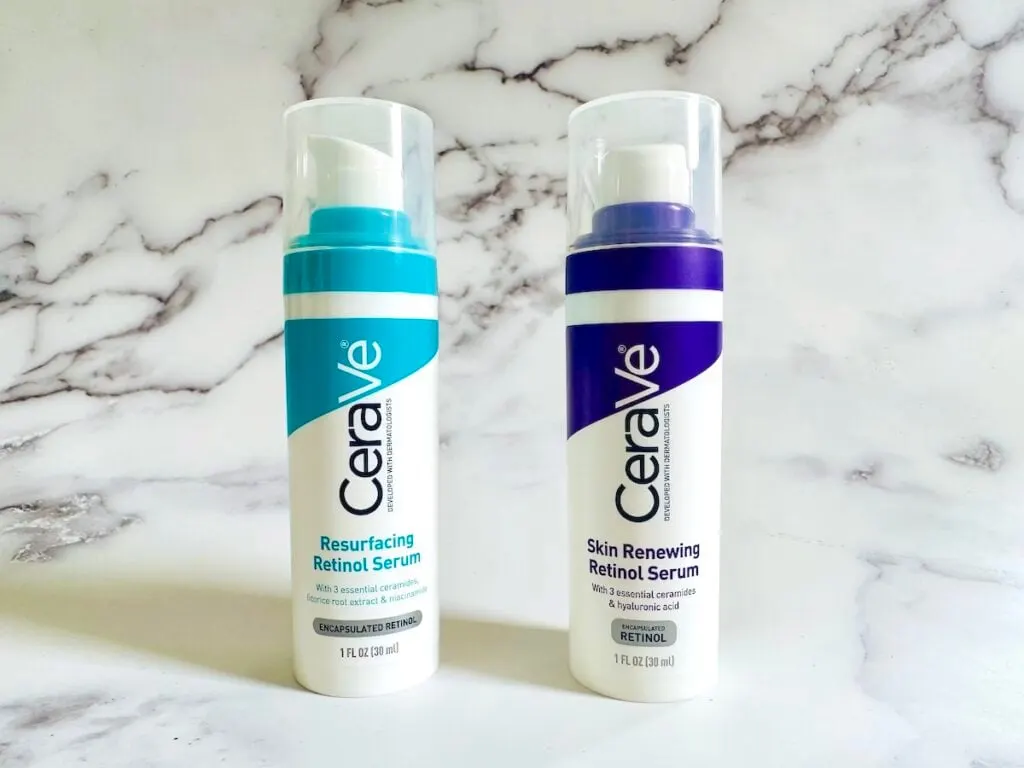
When it comes to CeraVe Resurfacing Retinol Serum and CeraVe Skin Renewing Retinol Serum, the bottles look alike (Resurfacing Retinol is blue/white and Skin Renewing is purple/white), and both are the same size at 1 oz.
So what is the difference between “Resurfacing” and “Renewing” since both contain retinol to improve cell turnover for smoother, brighter skin?
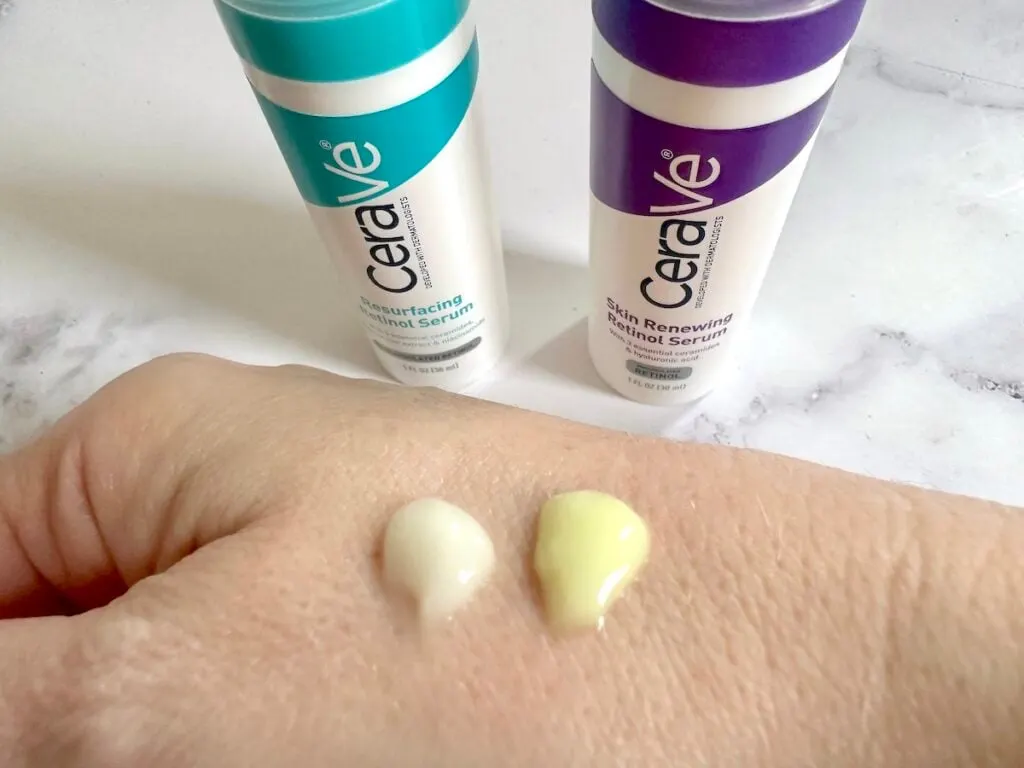
| CeraVe Resurfacing Retinol Serum | CeraVe Skin Renewing Retinol Serum | |
|---|---|---|
| Skin Concern | ✅ Acne scars, enlarged pores, uneven skin texture | ✅ Visible signs of aging, like wrinkles and fine lines |
| Ingredients | ✅ Retinol, ceramides, niacinamide, hyaluronic acid, MVE Technology, licorice | ✅ Retinol, ceramides, niacinamide, hyaluronic acid, MVE Technology, cholesterol, small amount of shea butter |
| Texture | ✅ Lightweight gel-cream | ✅ Lightweight gel-cream |
| Fragrance | ✅ Fragrance-free and non-comedogenic (won’t clog pores) | ✅ Fragrance-free and non-comedogenic (won’t clog pores) |
| Retinol Concentration | ❌ Not disclosed | ❌ Not disclosed |
Skin Concern
CeraVe Resurfacing Retinol Serum targets acne scars, enlarged pores, and uneven skin texture, while Skin Renewing Retinol Serum targets the visible signs of aging, like wrinkles and fine lines.
Ingredients
Both serums contain retinol, ceramides, niacinamide, hyaluronic acid, and CeraVe’s MVE Technology, a time-release formula that ensures the moisturizing ingredients are slowly released over time for maximum efficacy.
Resurfacing Retinol Serum also contains licorice for extra brightening benefits.
Skin Renewing Retinol Serum contains additional nourishing ingredients like cholesterol and a small amount of shea butter.
Texture
Both serums have a lightweight gel-cream texture that sinks into the skin quickly without leaving your skin feeling greasy or oily.
Skin Renewing Retinol Serum has a light yellow shade, and Resurfacing Retinol serum is a cream shade.
Price
Prices will vary depending on where you purchase the serum, but Retinol Resurfacing Serum currently costs slightly less than Renewing Retinol Serum at Target.
Retinol Concentration
Neither brand discloses its retinol concentrations (see more details below).
CeraVe Retinol Percentage
There are some claims online that CeraVe Resurfacing Retinol Serum contains 0.3% retinol, BUT this does not come from CeraVe.
When it comes to CeraVe retinol percentage, unfortunately, CeraVe does not disclose retinol percentage.
I reached out to CeraVe and received the response that I was expecting:
“Ingredients may have different functions in products depending upon their combination with other ingredients. The percentage of specific ingredients in any given product is not a measure of the ingredient’s efficacy. It is the unique formula and technology that provides the desired result. Except for active ingredients, information regarding the function and percentage of specific ingredients in our products is proprietary.”
CeraVe Consumer Care Center
CeraVe Resurfacing Retinol vs Skin Renewing Retinol Serum: CeraVe’s Comparison
I also asked CeraVe what the differences are between the serums. Here is CeraVe’s response:
“The difference between these two products is that, while both serums contain retinol, the products are formulated differently to provide specific benefits. Our Resurfacing Retinol Serum is formulated to help improve the look of post-acne marks, minimize the visibility of pores, and refine the skin’s overall tone and texture. While our Skin Renewing Retinol Serum is formulated to help improve the appearance of fine lines, skin texture, and radiance.”
CeraVe Consumer Care Center
CeraVe Resurfacing Retinol Serum
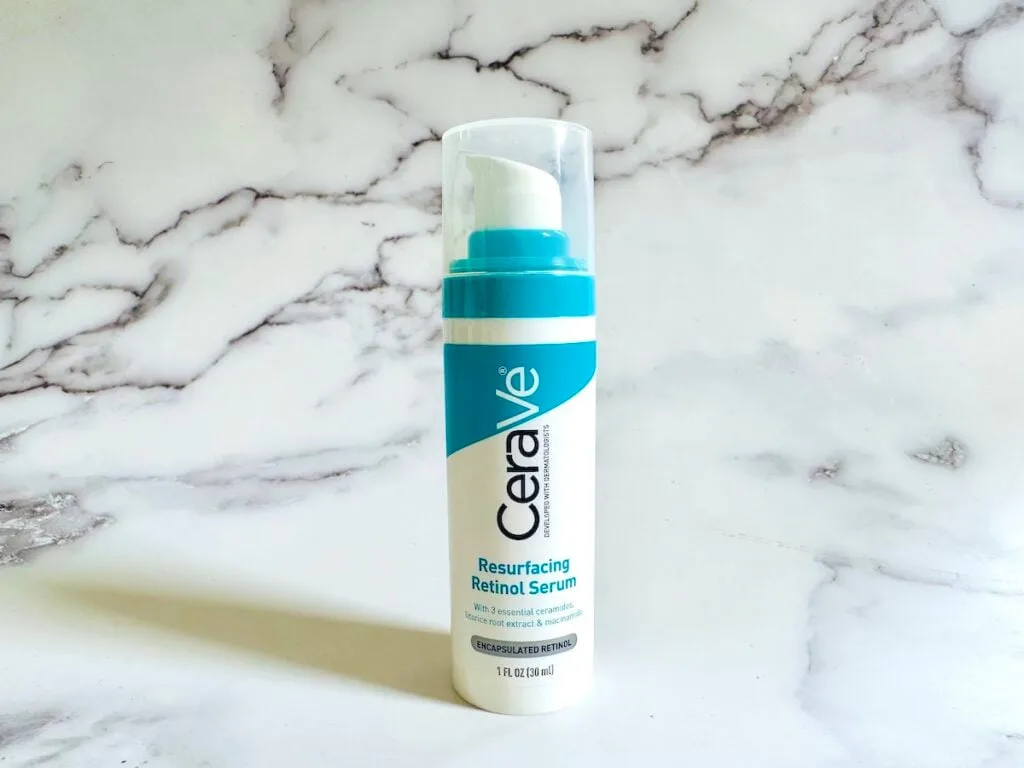
CeraVe Resurfacing Retinol Serum for post-acne marks and pores targets acne scars and uneven skin tone with encapsulated retinol.
Encapsulated retinol is a slow-release form of retinol that is gentler on the skin than retinol that isn’t encapsulated. It improves cell turnover and removes dull, dead skin cells for smoother skin texture.
It takes two conversions in your skin for retinol to be available in its active form. First, it has to be converted to retinaldehyde and then to retinoic acid.
Retinoic acid is the active form of retinol that can offer your skin benefits and is the ingredient in many prescription acne treatments like Retin-A (tretinoin).
CeraVe Resurfacing Retinol Serum Key Ingredients
- Retinol: A form of vitamin A that addresses multiple skin issues like uneven skin tone, rough texture, enlarged pores, dullness, acne, and wrinkles.
- Dipotassium Glycyrrhizate: A brightening agent from licorice that fades dark spots. It’s also anti-inflammatory and helps balance oil (sebum) production, so it’s perfect for oily skin.
- Three Essential Ceramides: Ceramide NP, Ceramide AP, and Ceramide EOP restore your skin’s protective barrier and hydrate your skin.
- Niacinamide: Multi-benefit ingredient that brightens skin, smooths fine lines and wrinkles, reduces inflammation and redness, minimizes pores, and supports your skin barrier.
- Sodium Hyaluronate: This salt form of hyaluronic acid acts like a sponge and draws moisture to your skin.
CeraVe’s MVE Technology ensures that the nourishing ceramides are gradually released over time for optimal effectiveness and long-lasting moisture.
The serum is non-comedogenic, which means it won’t clog pores and cause acne or breakouts, which makes it ideal for acne-prone skin.
The fragrance-free serum has a light, gel-cream texture that quickly absorbs into the skin without leaving any residue behind.
Related Post: Olay Retinol 24 vs CeraVe Resurfacing Retinol Serum
CeraVe Skin Renewing Retinol Serum
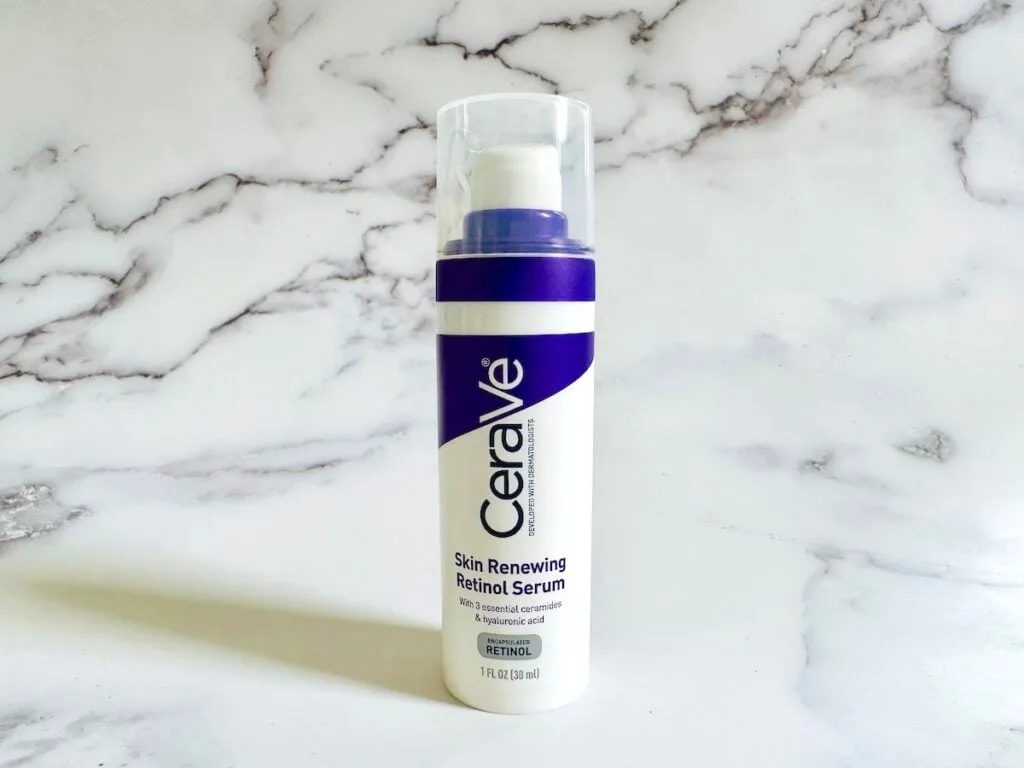
CeraVe Skin Renewing Retinol Serum is targeted at different skin concerns than Resurfacing Retinol Serum, such as wrinkles and fine lines, and other visible signs of aging.
The CeraVe treatment serum contains more active ingredients than CeraVe Resurfacing Retinol Serum, mostly replenishing and nourishing ingredients.
CeraVe Skin Renewing Retinol Serum Key Ingredients
- Encapsulated Retinol: Increases cell turnover and boosts collagen production for smoother, firmer, more youthful-looking skin.
- Three Essential Ceramides: Ceramide NP, Ceramide AP, and Ceramide EOP restore your protective skin barrier for improved moisture retention.
- Niacinamide: Brightens and evens skin tone, calms inflammation, smoothes fine lines, balances oil production, reduces the appearance of enlarged pores, and strengthens your skin barrier.
- Cholesterol: Replenishes your skin barrier and locks in moisture.
- Tocopherol (Vitamin E): Protects from free radical damage.
- Hydrolyzed Hyaluronic Acid: A low-molecular-weight hyaluronic acid that penetrates deeper into your skin for long-lasting hydration. Perfect for dehydrated and dry skin.
- Shea Butter: An antioxidant-rich emollient that soothes and nourishes your skin.
CeraVe MVE Technology (MultiVesicular Emulsion technology) delivers ceramides into your skin over time for long-lasting moisture.
Like Resurfacing Retinol Serum, Skin Renewing Retinol Serum has a gel-cream texture, is non-comedogenic and fragrance-free.
CeraVe Skin Renewing Retinol Serum Retinol Percentage
As previously mentioned, I messaged CeraVe asking about the retinol percentage in both serums, and they would not disclose the amount of retinol in each serum.
In both retinol serums, retinol falls in the middle of the ingredient lists (ingredient lists contain ingredients in order of concentration), but that doesn’t really tell us much.
My own anecdotal two cents are that both serums do not contain high concentrations of retinol since my somewhat sensitive skin tolerates both serums without irritation.
How To Use CeraVe Retinol Serums
Use Cerave Resurfacing Retinol Serum OR Cerave Skin Renewing Retinol Serum once daily in the evening.
Start with clean, dry skin (you can use a CeraVe acne cleanser first) and apply a small amount of the serum on your face (and neck if tolerated), avoiding the delicate eye and lip area. Follow with a moisturizer to help lock in moisture.
Be sure to finish your AM skincare routine with a broad-spectrum sunscreen with an SPF of 30 or higher, as retinoids like retinol can make your skin more sensitive to sunlight.
If you have never used a retinol product before, start by using it once a week for a week, twice a week for two weeks, every other night for three weeks, and gradually work up to every night as your skin tolerance increases.
The Benefits of Retinol
You might be wondering why you should try either of these retinol serums.
Retinol is a retinoid and form of vitamin A that increases cell turnover and removes dead skin cells from the skin’s surface. This can help to improve the appearance of fine lines, wrinkles, and uneven skin tone.
It also helps to stimulate the production of collagen, resulting in firmer, younger-looking skin. Collagen is a protein that gives our skin its structure. (As we age, our bodies produce less and less of it.)
Retinoids can also help even out skin tone and improve discoloration by lightening dark spots left behind by sun damage and acne scars.
Speaking of acne, retinoids can even help treat acne by improving cell turnover and preventing clogged pores by normalizing keratinization, the process by which our skin cells shed.
Of course, if you have sensitive skin, you’ll want to approach retinoids with caution, as they can cause irritation, redness, and flaky skin.
Luckily CeraVe retinol serums appear to contain lower amounts of retinol which make them better suited to beginners.
Alternatives To CeraVe Retinol Serums
There are many alternatives to CeraVe retinol serums that offer similar skin smoothing benefits at an affordable price:
The Ordinary Retinol 0.5% In Squalane
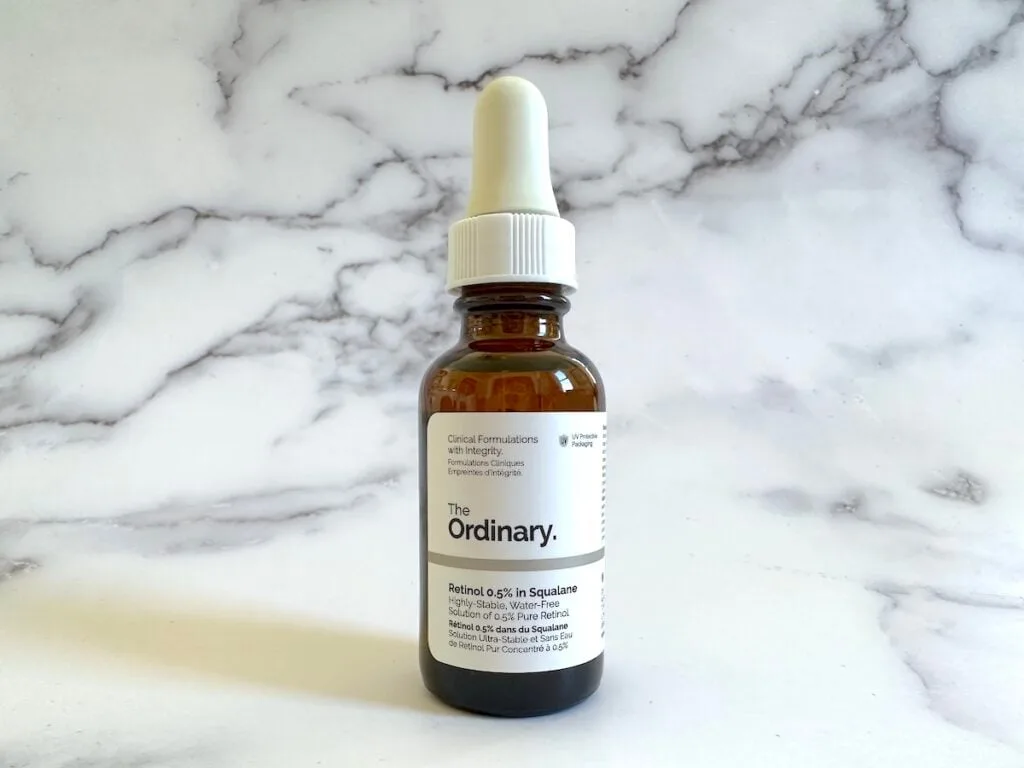
The Ordinary Retinol 0.5% In Squalane is a lightweight serum formulated with a moderate strength of 0.5% pure retinol, making it a great choice for those transitioning from lower concentrations.
Enhanced with a squalane base, this water-free formula provides a boost of hydration, counteracting the potential dryness often associated with retinol.
L’Oreal Revitalift Derm Intensives Night Serum With 0.3% Retinol
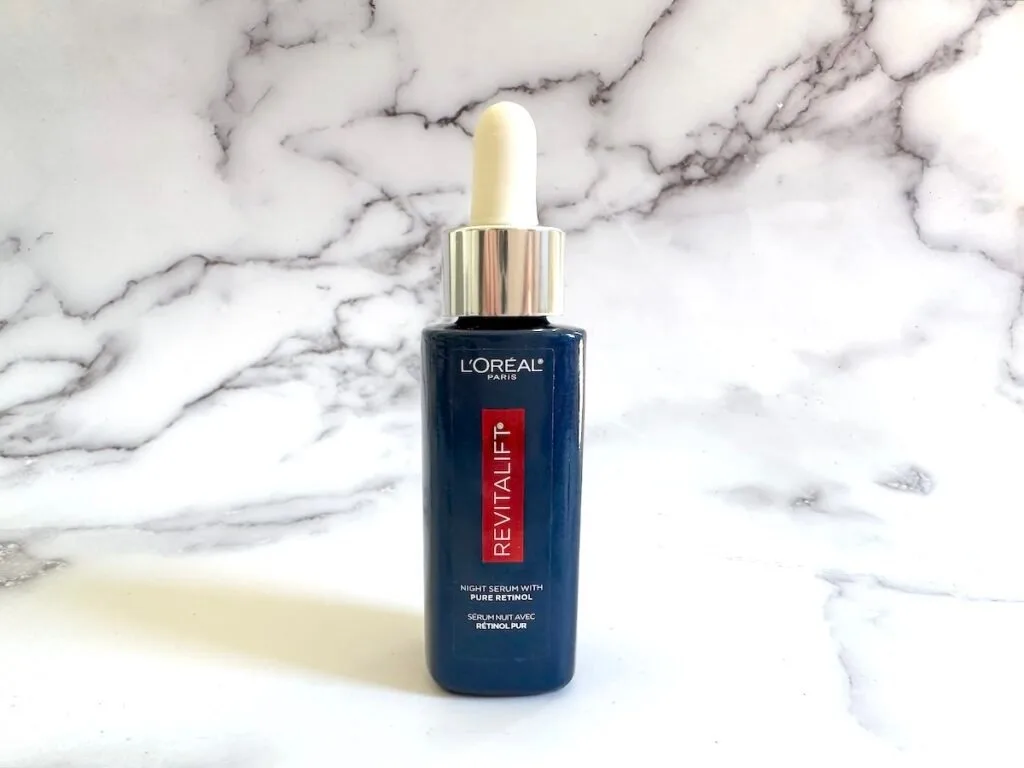
L’Oreal Revitalift Derm Intensives Night Serum With 0.3% Retinol contains 0.3% pure retinol formulated with L’Oreal’s proprietary Retinol Guard technology, which helps maintain potency and stability.
With added glycerin and hyaluronic acid, this L’Oreal retinol serum hydrates and moisturizes while counteracting retinol’s drying effects.
Over time, the serum refines skin texture, reducing wrinkles and enhancing brightness.
Olay Retinol 24 Night Serum
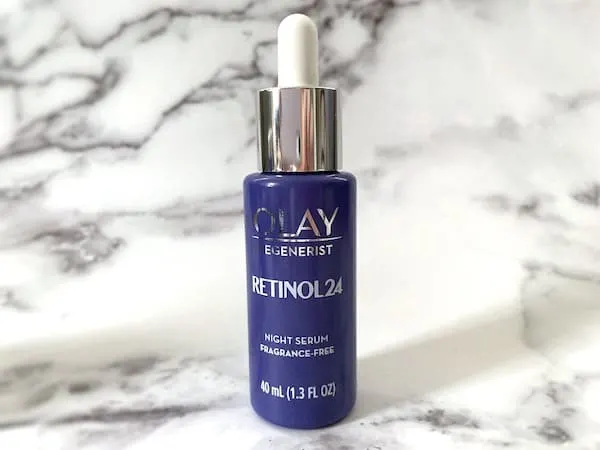
Olay Regenerist Retinol 24 Night Serum is a stand-out drugstore retinol serum for its ability to improve fine lines and wrinkles, smoothness, and brightness while targeting dark spots and uneven skin tone.
Formulated with a potent blend of retinol and retinyl propionate plus vitamin B3 (niacinamide), this retinol serum visibly refines skin texture and minimizes pores.
For an even more intensive Olay retinol treatment, consider Olay Retinol 24 MAX Night Serum, which contains 20% more Retinol 24 Hydrating Complex.
FAQs – Frequently Asked Questions
CeraVe Resurfacing Retinol Serum is formulated to target acne scars, enlarged pores, and uneven skin texture, while CeraVe Skin Renewing Retinol Serum addresses the visible signs of aging, such as wrinkles and fine lines.
While both retinol serums contain key ingredients like retinol, ceramides, niacinamide, and hyaluronic acid, Resurfacing Retinol Serum contains licorice for brightening, and Renewing Retinol Serum contains cholesterol and shea butter for nourishing your skin.
No, CeraVe does not provide specifics on retinol concentration in either serum.
Common side effects of retinol include dryness, peeling, and a slight increase in sun sensitivity. It’s essential to wear a broad-spectrum sunscreen with an SPF of 30 or higher daily when using retinol products and for 7 days after.
Some individuals may experience a purging phase when introducing retinol products, including those from CeraVe, into their skincare routine. Skin purging refers to a temporary increase in breakouts or blemishes when starting a new skincare product that accelerates the skin’s cellular turnover rate.
Retinol promotes faster cell turnover, which can bring underlying microcomedones (small, non-inflamed acne lesions) to the surface faster, resulting in a temporary increase in breakouts. Not everyone will experience skin purging, and for those who do, it typically subsides after a few weeks as the skin adjusts to the product.
For more of the best retinoid and retinol products, be sure to check out these posts:
Thanks for reading!


Gabriel
Wednesday 30th of August 2023
Thanks for all the explanation and info, this is amazing. Much appreciated <3
Sarah
Thursday 31st of August 2023
Of course, glad to help!
Cristina
Sunday 27th of August 2023
I am so pleased I found this site. I am surprised I never saw it before. I found the reviews well-written, covering all aspects of the products. Thanks for sharing your knowledge.
Sarah
Monday 28th of August 2023
That's so nice of you to say! Thank you so much!